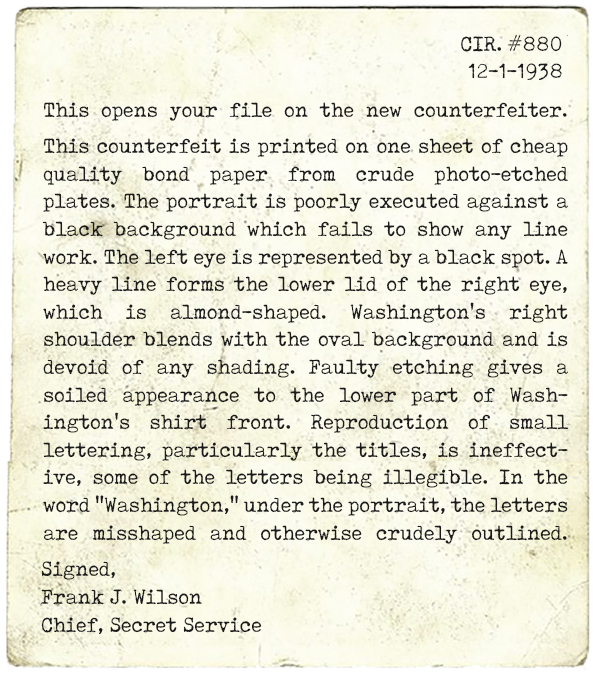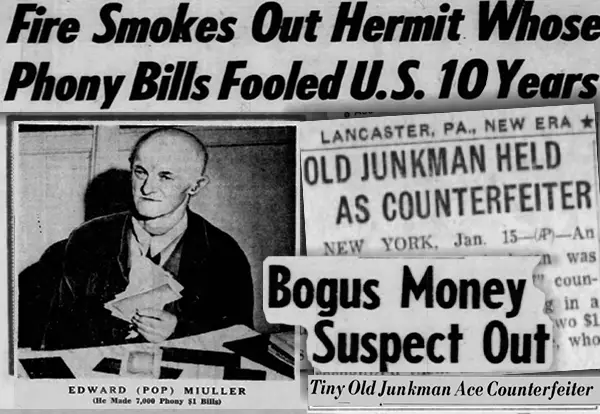 he U.S. Secret Service wasn’t sure whether the counterfeit one-dollar bills that were popping up all over New York City were a hoax or a master plan, senseless as they seemed, yet so genius. It made no sense to go to all that trouble over a one-dollar bill. No one has ever counterfeited a one-dollar bill, and yet it was ingenious how easy it was to distribute them since no one questions one-dollar bills.
he U.S. Secret Service wasn’t sure whether the counterfeit one-dollar bills that were popping up all over New York City were a hoax or a master plan, senseless as they seemed, yet so genius. It made no sense to go to all that trouble over a one-dollar bill. No one has ever counterfeited a one-dollar bill, and yet it was ingenious how easy it was to distribute them since no one questions one-dollar bills.
But you can’t get rich counterfeiting such a small amount, and the ten-year investigation was much more expensive than the damage caused by counterfeit bills, so it all looked like a prank until 1948 when, by sheer coincidence made possible by the counterfeiter’s negligence, the truth came to light.
As with many almost-perfect crimes, the perpetrator would never be caught if he hadn’t made himself known. If Mister 880 had thrown away his counterfeit tools and bills before a fire broke out in an adjacent apartment and firefighters had to enter his apartment to find it filled to the brim with junk that they threw out the window into the alley to make room, the neighborhood boys would never find it playing and their parents wouldn’t report their strange finds of silly, fake one-dollar bills.
Mister 880 is a 72-years old junk collector
Believing they had finally found the criminal mastermind after ten years of searching, the agents broke into his small apartment and found a good-humored 72-year-old with “a healthy pink face, bright blue eyes, a shiny bald head, a white fringe of hair over his ears, a shaggy white mustache, and hardly any teeth.” It was the old junk collector Emerich Jeuttner, who lived with his dog and seemed unimpressed by everything and endearingly detached.
Before answering questions, he paused and smiled brightly. When asked how long he’s been making these bills, Jeuttner casually admitted, “Oh, nine or ten years, a long time. Of course, I admit it. They were only one-dollar bills. I never gave more than one of them to one person.”
As it turned out, the most wanted counterfeiter in the U.S. Secret Service, who never passed the counterfeit money twice in the same transaction and whose fake $1 bill looked as if a child had made them and printed them on cheap New York stationery, was a poor old pensioner with a dog who did this to survive the Great Depression and World War II. He never tried to counterfeit bigger bills and get rich. For him, it wasn’t about greed, it was about hunger and his dog, as he later said to the judge.
Now the funny-looking fake bills made more sense and the agents understood why George Washington looked like a prank, had black holes instead of eyes, and was misspelled. When they searched the apartment, they found a printing press, ink, photo negatives, and a drawer full of counterfeit $1 bills that they have been collecting for ten years, alarming more than 10,000 businesses and handing out more than 200,000 warning posters.

Emmerich Juettner sells film rights and gets more money than he ever forged
Emerich Juettner, an Austrian immigrant also known as Edward Mueller or Mister 880, was the first and so far only person convicted of counterfeiting $1. However, when the U.S. Secret Service got to know him, they asked for a more lenient sentence. After ten years of searching for America’s most wanted counterfeiter, agents wanted to talk to everyone who knew him, from neighbors to store owners to his adult children. They were surprised for the second time to find that everyone had nothing but praise for Juettner, describing him as a helpful and cheerful man with a bald head and bright blue eyes, who took good care of his dog and was always friendly.
Emerich came to New York on a ship from Austria as a 14-year-old boy. He found work gilding picture frames before marrying in 1902 at the age of 26. His wife gave birth to a son, Walter, in 1903 and a daughter, Florence, in 1918. To support his family, he began working as a janitor on New York’s Upper East Side, which allowed him and his family to live rent-free in the basement of the building where he worked. The years flew by until his wife died unexpectedly in 1937, leaving Juettner, then 61, alone, too old to work in maintenance and in financial need.
His children had long since moved out and the U.S. was in a deep economic crisis with no work for his age group. So Emerich got a used, two-wheeled wheelbarrow and spent long days roaming the streets of New York, picking up the scrap and trying to make something out of it. But there wasn’t enough money in it, and Juettner soon realized that if he wanted to keep his apartment on 96th Street in NYC, he had to find a better solution.
One morning in November 1938, he photographed a $1 bill, transferred the images to a pair of zinc plates in an acid bath, and then simply filled in small details of the bill by hand. Juettner told the judge that he had learned the basics of engraving in Austria and that he didn’t want to worry his children by asking them for money. His sentence was supposed to be 15 to 30 years, but the judge imposed a sentence of one year and one day, making Juettner eligible for parole in four months. And the mandatory but small fine: $1.
In 1950, the Hollywood film Mister 880 starring Burt Lancaster and Edmund Gwenn hit theaters, and Juettner’s gentle, unusual story became a romantic comedy hit that melted many hearts.

Writer and director who thinks different and does everything differently. Art enthusiast. Wandering and wondering. Until the end of meaning.
irena_curik@hotmail.com





